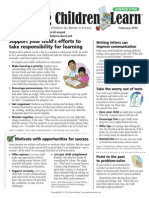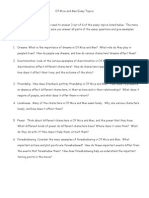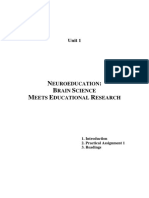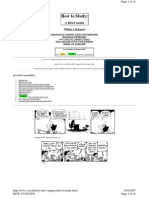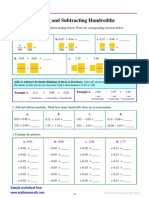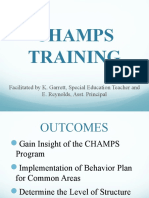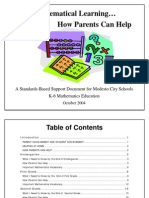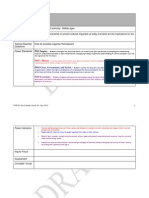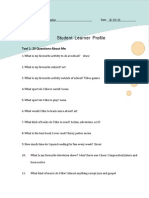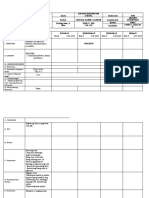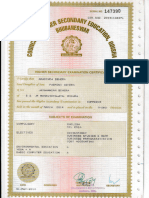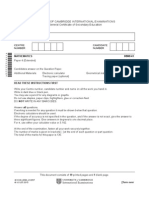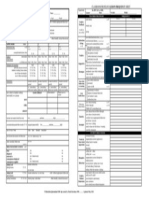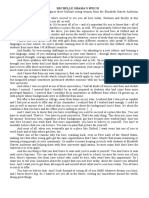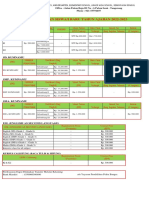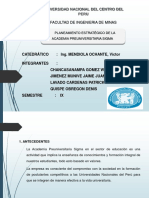One of a Series of Booklets for Parents
Highgate Elementary School
Highgate Center, Vermont
Take a Math Walk
W
hen you and your child walk in your
neighborhood, count the number of
animals, birds, fire hydrants or green
cars you see. Look for geometric
shapescircles, right angles, cones and so onin the
windows and buildings. Estimate how far youll walk
later, perhaps you can check with a car odometer.
1
M
ath is around us all the time. And in todays high-tech
society, everyone needs a strong foundation in math
to be successful. Workers need quick reasoning and
problem-solving skills. They need to estimate and use
mathematical thinking.
Even calculators and computers, which some said would make
math outdated, require students to have good math skills. In fact,
because calculators are only as accurate as the people operating
them, these machines make it even more important for students to
have strong mental math skills so they can tell quickly if the answer
is correct.
Sometimes, children dont see how useful math can be. Parents
can help. When you or your child use math in your everyday activi-
ties, point it out. Did your child glance at the clock to see how many
minutes remain before his favorite TV show? Thats math. Did he
figure how many weeks allowance it will take before he can buy a
new video game? Thats math, too.
Whether youre looking for extra math activities to enjoy with
your child or advice on how to help a struggling student do better,
the activities in this booklet should help. By working on these activi-
ties with your child, he* can develop a healthy interest in math, an
appreciation of why math is useful and a positive attitude about
studying math in school.
*Every child is unique, so we often use the singular pronoun. Well
alternate using he/him and she/her throughout this booklet.
Ask a Silly Question
Try making math fun by asking
your child silly questions that
require math to answer them:
How many minutes are there
until your birthday? What
percent of the pizza did Dad
eat tonight? After you ask the
question, ask your child how
she could find the answer. Have
her solve the problem with pencil
and paper or a calculator.
Challenge each other to think
of new fun questions.
Copyright 2009
The Parent Institute www.parent-institute.com
Downloaded by 75.147.12.51 on January 09, 2014 at 11:44
Highgate Elementary School
Highgate Center, Vermont
X02706487
Theres More Than One Right
Way to Get the Answer
C
hildren sometimes think that because theres only one
correct answer to a math problem, theres only one way
to come up with the answer. In fact, there may be many
ways to get the right answer. When youre studying
math at home with your child, stop often to ask, How did you get
the answer? Your childs way may be different from yours. If the
answer is correct, his method may be a great alternative. Getting
children to think about how they solve problems makes them better
mathematicians.
Use Manipulatives
Whats the difference between 5 x 2 and 2 x 5?
Both problems give the same answerbut the
groupings are different. Children of all ages can
often understand math concepts if they have a
chance to see, move and use objects.
Teachers call these objects manipulatives
because they give children a chance to move
them around as they are learning about a math
concept. You can create your own math manipu-
latives. Look for something smallraisins, paper
clips, beans, even candy pieces.
To help your child see the difference between
5 x 2 and 2 x 5, have him group ten raisins
first into five groups of two, then into two groups
of five. As he moves the manipulatives around,
hell begin to understand how the two problems
are different, even though they have the same
answer.
Stress Mental Math
C
alculators and computers are great, but the
people using them still need to know if the
answer they give is reasonable. So children
need the ability to do mental mathcoming
up with an estimate of the answer in their heads. Here
are some ways to foster mental math skills:
Ask your child to give you a quick answer to lots
of small math problems. For example, Ive put in
four cups of flour, but the recipe calls for seven. How
many more do I need? I need to bring 24 drinks
for your class party. They come in packages of six.
How many packages should I buy?
Teach your child to estimate an answer.
Sometimes, that means using numbers that make it
easier to do a problem in your head. Its hard to add
18 and 29 quickly, but its easy to add 20 and 30. So
the answer to 18 plus 29 should be about 50.
Ask often, Is the answer reasonable? Is it reason-
able to add 17 and 35 and get 367? Why or why not?
Ask for your childs help as you use math. At
the grocery store, ask your child to weigh vegetables,
count items in the cart, compare unit prices or esti-
mate your total grocery bill. Or use coupons to teach
math. Ask, If this coupon gives us 25 cents off,
what will the final price be?
2 3
Copyright 2009
The Parent Institute www.parent-institute.com
Downloaded by 75.147.12.51 on January 09, 2014 at 11:44
Highgate Elementary School
Highgate Center, Vermont
X02706487
4 5
Heres the Secret to
Solving Word Problems
E
ven kids who do well in
math can sometimes get
confused by word problems.
Help your child follow these
five steps when solving any word
problem.
Step 1: Figure out the question
you need to answer. The first thing you
need to know is what you are trying to find.
(Often, this is the last sentence of the problem.)
Step 2: Write down the information
needed to solve the problem. A word problem includes
all the information needed to answer the question
(although it may also include some extra information).
Step 3: Develop a plan to solve the problem.
There may be one step to solving the problem, or several. It
may be possible to use a diagram or a table. Its important
to have a clear plan in mind before solving the problem.
Step 4: Solve the problem. Make sure you
check your plan so you dont leave out any steps.
Step 5: Check your work. Did you answer the
problem completely? Reread the problem to see if your
answer makes sense. Check your answer to make sure
you havent made a simple error.
Heres how your child might
use the five-step plan to solve
the following word problem:
Each Monday of the month for six months you
have put 1/10 of your allowance in your pink
piggy bank. If you now have $7.00 in your piggy
bank, how much allowance have you earned?
You may want to make a copy of these 5 steps and keep it handy
for the times when your child is solving word problems.
My 5-Step Plan for Solving Word Problems
Step 1: Figure out the question HOW MUCH ALLOWANCE
I need to answer. HAVE I EARNED?
Step 2: Write down the information I HAVE SAVED $7.00 IN MY
needed to solve the problem. PIGGY BANK. I HAVE SAVED
1/10 OF MY ALLOWANCE.
Step 3: Develop a MULTIPLY THE AMOUNT
plan to solve the problem. IN MY PIGGY BANK BY 10.
Step 4: Solve the problem. $7 X 10 = $70
Step 5: Check my work. YES, THE ANSWER
IS CORRECT.
Copyright 2009
The Parent Institute www.parent-institute.com
Downloaded by 75.147.12.51 on January 09, 2014 at 11:44
Highgate Elementary School
Highgate Center, Vermont
X02706487
6 7
Thinking Games Build Math Skills
M
ath involves a specific way of thinking.
You can use games to help your child
build the thinking skills needed in this
important subject. Here are some ideas:
Help your child see patterns. For example, ask
your child to figure out the next number in this series:
10 11 13 16 20 25 _____
(The correct answer is 31add 1, then 2, then 3, and so on)
Whats the next number in this series?
72 27 56 65 41 _____
(The correct answer is 14reverse the digits.)
Use math to crack a coded message.
The key to this code is that each letter has a numerical
value starting with A=1, B=2, C=3, etc. to Z=26. Then the
number code for each letter is multiplied by five, so that
the code for A becomes 5 (1 x 5 = 5), the code for B
becomes 10 (2 x 5 = 10), etc. Using that key to the code,
see if you can decipher the following message:
125-75-105 35-75-100
45-100 90-45-35-40-100!
Can you and your child make up your own
math-based code?
Use the Newspaper for a
Math Scavenger Hunt
C
hildren in the upper elementary grades
will enjoy using the newspaper for
a math scavenger hunt.
See if your child can find:
a graph
a number less than 10
something that comes in 2s, 3s, 4s
a number greater than 50
the date
a number greater than 100
a number that is greater than 100 but less than 999
a symbol or word for inches, feet or yards
a schedule of some kind
a triangle
a weather symbol
a percent sign
sports statistics
Answer:
YOU GOT IT
RIGHT!
Copyright 2009
The Parent Institute www.parent-institute.com
Downloaded by 75.147.12.51 on January 09, 2014 at 11:44
Highgate Elementary School
Highgate Center, Vermont
X02706487
Card Games Teach Math Skills
H
ere are two
card games
to teach
math skills:
For this game, youll need the cards
from 1 to 9 in each suit. Give each
player four cards. Have players use
addition, subtraction, multiplication
and division to see how many math
problems they can create in a specific
amount of time using those four
numbers. Award one point for each
answer. Heres how a player might
write problems using 3, 5, 6 and 8:
3 + 5 + 6 + 8 = 22
(8 x 5) (6 3) = 38
(5 3) + (8 6) = 4
(6 x 3) + 8 + 5 = 31
For this game, youll need cards 1
through 10 in all four suits. Deal out
half the deck to each of two players.
Then have players turn over two cards
each. The player who can make the
largest fraction from the two cards
showing takes all the cards. The first
person to collect the entire deck wins.
8 9
Have Fun With
Fractions and Decimals
Number lines can help children understand
fractions and decimals.
0________________________________________1
Write a list of fractions1/8, 1/4, 1/6, 1/2, 1/5, 1/3,
1/10, and so on. Have your child put those fractions on
the line above in approximately the place where they
should go. This will help him get a mental picture of the
value of a fraction. Repeat with a wider variety of frac-
tions3/10, 4/5, 5/8, 1/2, 1/3, and so on. You can do
the same with decimals. See who can come up with the
largest or smallest five-digit decimal that could go on the
line: .99999, for example, or .00001.
Use a pizza to help children see fractions.
Cut the pizza into halves, quarters and eighths, or into
thirds, sixths and twelfths. This way, your child can see
clearly that 2/4 is the same as 1/2, or that 2/6 is
the same as 1/3.
When youre in the kitchen,
use measuring cups to help your
child understand fractions. Use
rice, popcorn or water and let your
child find the answer to questions
like these:
How many times will you have
to fill up the 1/4 cup measure
before the cup measure is
filled? (4)
How many 1/4 cup measures
will fill up the 1/2 cup
measure? (2)
Is 1/3 cup plus 1/4 cup more or
less than 1/2 cup? (more)
Copyright 2009
The Parent Institute www.parent-institute.com
Downloaded by 75.147.12.51 on January 09, 2014 at 11:44
Highgate Elementary School
Highgate Center, Vermont
X02706487
10 11
Use License Plates to
Teach Math Skills
W
hen youre in the car, you can use license plates on
other cars to teach math skills. Young children can
read the numbers. Older children can try to add the
numbers quickly in their heads.
As your child gets older, you can try different problems using the
numbers on the license plate. For example, if you use the plate number
663M218, ask your child if he can:
make a 1 using two numbers? 3 - 2 = 1
make a 1 using three numbers? 6 - (3 + 2) = 1
make a 1 using four numbers? (6 + 6) - 8 - 3 = 1
make a 1 using five numbers? 3 - [(6 + 6) - 8 - 2] = 1
make a 1 using six numbers? 8 x 2 - (6 + 6) - 3 = 1
Help Older Students
Get Over Math Anxiety
S
ome students may
be so anxious about
math that they cant
do their best. Here
are some teacher-tested tips
on turning math anxiety into
math success:
Point out that boys
and girls can do equally
well in math. The idea that
boys are better than girls in
math is a cultural myth
unique to some countries.
In other countries the belief
is that girls are naturally
better than boys in math
and the girls are expected to
help the boys learn math.
Be positive. Students who think
they can do well in math usually do.
Students know that an I can do it! attitude helps in
sports and many other areas. Point out that attitude also
makes a difference in math.
Be prepared. The way to do well in math is by
studying every day. There is no magic to success in music,
reading, spelling or any other subject, including math.
The key is to study and practice, practice, practice.
Use errors as learning opportunities. If your
child gets a problem wrong on a test, have her rework it
as soon as possible. Nearly everything can be learned
through trial and error. Your child will try something,
figure out what she did wrong, try again, do a little better
and try againuntil she gets it right. Thats how she
learned to talk, walk, ride a bike, write her name, etc.
and its true for math, too. We learn through our mistakes.
Copyright 2009
The Parent Institute www.parent-institute.com
Downloaded by 75.147.12.51 on January 09, 2014 at 11:44
Highgate Elementary School
Highgate Center, Vermont
X02706487
What Parents Can Do at Home to Help Students With Math is one of six titles in The Academic
Achievement Series of booklets for parents published by The Parent Institute, P.O. Box 7474,
Fairfax Station, VA 22039-7474. Call (800) 756-5525. www.parent-institute.com
English Stock # 316A, Spanish Stock # 416A
Copyright 2009, 2006, 1999 The Parent Institute, a division of NIS, Inc.
Publisher: John H. Wherry, Ed.D. Writer: Kristen Amundson. Managing Editor: Patricia Hodgdon.
Staff Editors: Erika Beasley, Amanda Blyth, Jennifer McGovern & Rebecca Miyares. Editorial Assistant:
Pat Carter. Translation Manager: Michelle Beal-Garca. Business Manager: Merissa Larson.
Marketing Director: Laura Bono. Marketing Assistant: Joyce Ghen. Customer Service Manager:
Peggy Costello. Customer Service Associates: Louise Lawrence, Cynthia Lees & Margie Supervielle.
Business Assistant: Donna Ross. Circulation Associates: Marsha Phillips & Diane Perry.
Graphic Design & Illustrations: Joe Mignella, Maher & Mignella, Cherry Hill, NJ.
Sports Statistics Can Build an
Interest in Math
M
any students who have never developed much
interest in math start to see its importance
when they develop an interest in sports. As
youre watching a game with your young
sports fan, try to keep your own statistics. For example:
What percentage of passes did the quarterback complete in
the first quarter?
What percentage of three-point shots did your favorite team make?
If a baseball players batting average is .325, how many times on
average does he get a hit for every 10 times at bat? How many
hits does he get for every 100 times at bat? How many hits
for every 1000 times at bat? (3.25 hits per 10; 32.5 hits per
100; 325 hits per 1000)
If a pitcher throws a ball at 90 miles per hour, how many
feet does the pitch travel in one second? (132 feet)
How do you compute a baseball pitchers Earned Run
Average (ERA)? A basketball players field goal percentage?
What other averages can you find in a newspapers sports
page and how do you compute them?
12 13
When You Need Help
T
here may come a time when
your child needs more help
in math than you can offer.
Where can you get help?
Your childs teacher may have suggestions. It may be
possible for your child to stay after school and use computerized
software to practice math skills.
A volunteer tutor may be able to help your child. In many
middle and secondary schools, honor students are often available
as tutors. Adult volunteers may provide extra help to students who
need it. Some schools organize networks of parent volunteers
one parent who is good in math helps students in that subject
while another parent offers assistance in reading or writing.
A professional tutor might also be an option. Again, the
teacher may offer some suggestions. While a private tutor can be
expensive, some tutoring centers offer scholarships or charge fees
on a sliding scale.
By tapping into your childs natural curiosity about the
world around her, you can help her develop a fascination
with numbers and a positive attitude about learning math
in school.
No matter what children do when they grow up, math is
sure to be a part of their lives. Helping children with math
today helps prepare them for future success.
number of
throw
s
caught
number of
throw
s
number of
baskets
number of
three-point
attempts
90 miles per
hour x 5,280
feet per mile
60 minutes
per hour 60
seconds per
minute
number of
baskets made
number of
field goal
shots taken
multiply the
number of
runs charged
(not counting
errors) by 9
innings, then
divide by the
number of
innings he
pitched
Copyright 2009
The Parent Institute www.parent-institute.com
Downloaded by 75.147.12.51 on January 09, 2014 at 11:44
Highgate Elementary School
Highgate Center, Vermont
X02706487
Licensed for distribution by Highgate Elementary School
through November 2014.










